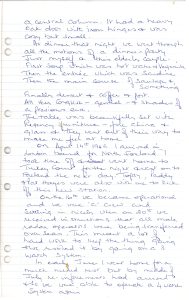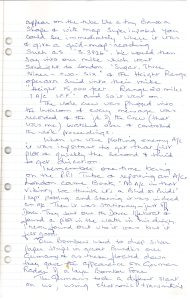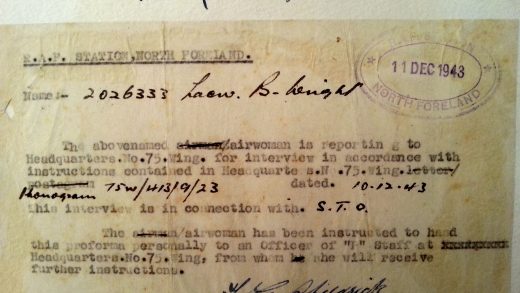Page 47


Page 47
On April 14th 1942, I arrived in London bound for North Foreland. I took time off and went home to Turkey Court for the night and went on to Foreland the next day. Topsy, Paddy and Pat Hayes were also with me to kick off this new station.
On the 16th we became operational and we were “C” crew and settling in nicely when on 20th we received instructions that all male radar operators were being transferred overseas. This meant a lot of hard work to keep the thing going and we resolved it by going on a 3 watch system.
I early June I went home for a much needed rest but by middle of July re-enforcements had arrived and so we were able to operate a 4 watch system again.
Page 48


Page 48
At this time WRNS started to arrive to plot shipping and keep and eye on Naval items as Foreland “swept” across the Thames Estuary.
In October that year, I went to Bromley to be interviewed for a Supervisors Course and ultimately a Commission in Radar. I would have liked it but “Quo Fata Vocant” was ever with me and the Fates were calling me to yet another path to walk. The next day I was made i/c of my crew. I would have been 20 yrs old and in charge of men much older than myself and also women.
I had Sheila Weeks, Topsiko, Cyril Griffiths, George, Myrtle, Steve (from London) and Ace – the Canadian mechanic.
About this time, we had a young American officer called (Lt Wilder) “Blodgie”attached to us. ‘He would have been about 21 or so and didn’t seem to know much about radar. He didn’t last too long! – then we had another – Uncle Sam II).
On February 28th 1943 Topsy and I were sent up to Trimmingham in Norfolk to work on “GEE” the Radar Beam used by the British bombers to home in on a target in Germany.
It was Trimmingham where C.T. Studd’s daughter lived during the war. She had married an Anglican Minister and he had the Church there. Three sons were born, one was lost in the Far East, one a fighter pilot was shot down in North Africa and one was too young to go. On Easter 1942 all three sons were together for Easter Communion. The Mother, the Army fellow and
Page 49


Page 49
the youngest were all sitting in the front pew about to commence communion when the door of the vestry opened and the father (the Minister) saw his Air Force son kneeling at the alter rail also. He wrote afterwards as he saw the young heads bowed – the khaki – the Air Force blue – the young teenager together with their mother, he was overcome with emotion. At that moment, a sunshine of sunshine penetrated the place where they knelt, leaving a precious never to be forgotten cameo of memory in his heart. He felt God had given that moment to him as a special gift.
When I was in London in October 1942 I saw “Watch on the Rhine” it was the first of many London shows I saw we used to queue up at the box office before the show and free passes were available to members of the Armed Forces. I used to go often to see Margot Fonteyn and Robert Helpmann at the Royal Ballet in Covent Garden London. One day a young Army officer in the queue wanted to get to know me better and I had to do the “Annie” to get rid of him, no doubt he was lonely and in London on his own and quite genuine – but it was too risky and in any case – that wasn’t the way I was brought up.
About this time we started to see paragraphs in the London papers about raids “going – out” to Germany and raiders “coming in” which we had plotted and reported. It was interesting and I
Page 50


Page 50
used to keep the cuttings.
If it was a RAF raid you would see the groups of bombers taking off on the Height Range Tube. The bright yellow line of the “Strobe Light” started to “blip” down in an active “V”‘s. As more and more aircraft joined the group the big V “blip”became more active jumping up and down and broadening all the time where it met the “Strobe”. A single stationery “blip” was one aircraft. If it beat up and down regularly it was 2 or 3 aircraft. If small blips started to occur either side leaping up and down you could estimate 10+ or 20+. Finally as the base broadened, you were reporting 50+ or 100+. When RAF aircraft flew singly or in a small group, they let an I.F.F. signal emanate from the plane. This was Identification Friend or Foe and we could see the I.F.F. signal by the extra “jump” on the end of the blip almost like dropping a tear-drop.
At the same time alongside the Height/Range tube which enabled us to read an estimate height of flight and range in miles from our Station we had the P.P.I. Tube. It had a perspex facsimile of the map of our immediate area with a “strobe” light from the centre of the tube to the edge. As our Transmitter/Receiver on the ops roof went round and round (we called it the Flying Bedstead) so the strobe went round and round.
As as signal was received it would
Page 51


Page 51
appear on the tube like a tiny banana shape and with map superimposed you could see immediately where it was and give a grid map reading. Such as “S. 3926”. We would then say into our mike which went straight to London, “Sugar Three Niner two six” and the Height Range operator said into the mike, “Height 15,000 feet, Range 20 miles, 1 aircraft I.F.F” and so it went on.
The whole crew was plugged into the intercom and every message was recorded and the In-Charge of the crew(that was me) watched over and controlled the whole proceedings.
When we were plotting enemy aircraft it was important to get that first plot and quickly the second and third to get direction.
I remember one time being on the P.P.I. Tube and reporting an aircraft, London came back “No aircraft in that vicinity, we think it’s a bird or birds”. I kept plotting and stating it ws indeed an aircraft. Then it was stationery – just off Dover. They sent out the Dover lifeboat and found a pilot in the water in his dingy. I never found out who it was, but it felt good.
Our bombers used to drop silver paper strips in great bundles over Germany and as these floated down they gave the appearance on German radar of a large bomber force.
The Germans took a different slant on us, using electronic transmitting
Page 52


Page 52
signals to swamp our strobe.
Sometimes it was like a fog and you could pick up one or two signals but on the night Canterbury was bombed our strobe lights were dancing all over the screens and it was hopeless. We heard them go over but couldn’t do a thing.
In 1942, I met “wee” Jones at a dance at Margate to which we all went as a group. He was a Flight Engineer and about to go on ops. He was a very good dancer and I enjoyed dancing with him. He seemed a nice fellow, very open and friendly and when he said his home was practically in the next street and would I like to come and meet his parents, I felt I could trust him to do so. So we went to this delightful home at Margate which over the next couple of years became a home away from home for me. Mr and Mrs Jones were quite lovely and loving. They were Methodists and keen church folk. Mr Jones was a builder and he had built this lovely modern “cottagey” home with big open fireplace in the lounge for his family; They just took me in and loved me. I used to go to the flicks with them mainly to see Laurel and Hardy films at which Mr Jones laughed himself silly. It was so close to camp and I went there whenever I could. When Roy, who was an only child came home on leave we used to go dancing
Page 53


Page 53
and cycling and to the pictures. He was good company. He was affectionate and friendly like his parents but then one day he asked me to marry him because he said he loved me.
as gently as I could, I said I enjoyed his company and I was very fond of him but it would be wrong to lead him up the garden path to believe I would marry him. He was distressed and asked if he could kiss me – which he did. After he had gone back to the squadron I went to see Mrs Jones and told her what had happened and what I had said to Roy. She was a dear and understood what I was trying to say. Then she said, “Can I ask you for something very special?” – I said, “Yes you can”. And she went on, “You haven’t anyone in your life at this moment have you? So – could I ask you please not to break your friendship with Roy, which you have told me, but continue with it as he is about to go on Op’s and I fear for what he might do if he looses you altogether”. So we agreed that I would not break off the relationship and so long as Roy and his parents knew where I stood I would stand alongside them and pray for his safe return. As a matter of fact of all the crews on his Stirling Bomber Squadron who started at the same time – Roy’s was the only crew to remain alive for one tour (30 ops)
After our trip to Trimmingham to work on GEE, topsy and I were sent back to
Page 54



North Foreland


The Sadlers Wells Ballet















Kingsgate castle
























Jo Edmondson Anne Baskerville and Constance Brooke Wright











Home away from home, local builder















































